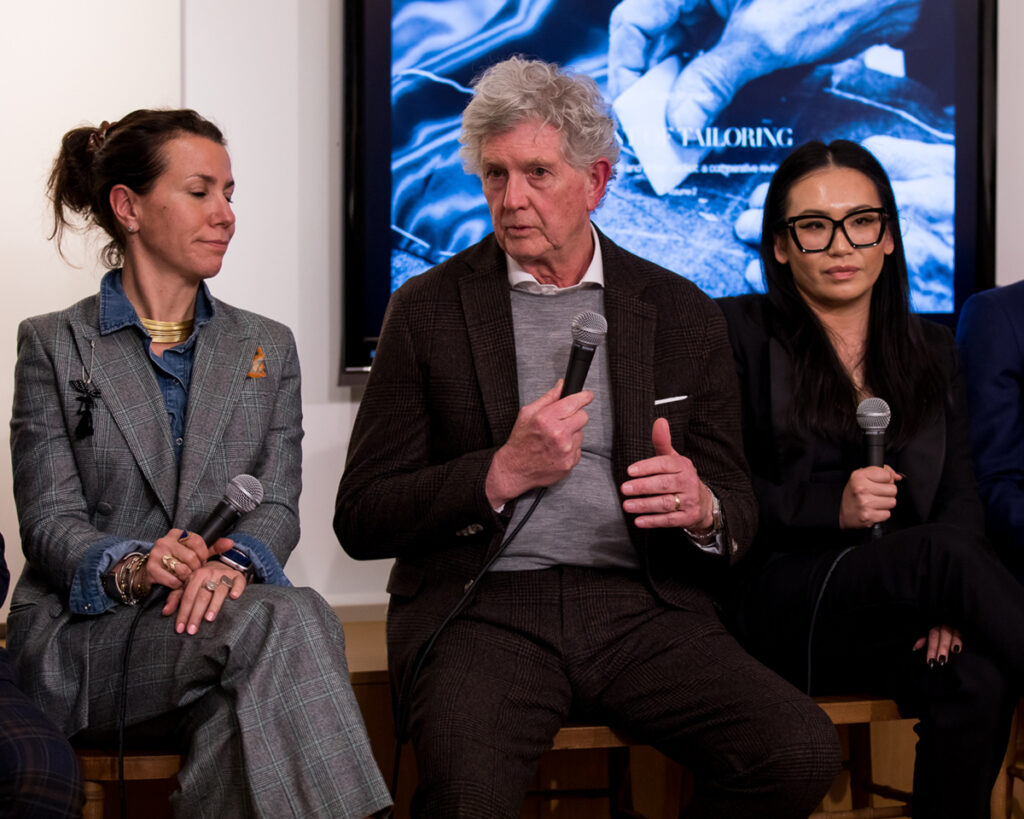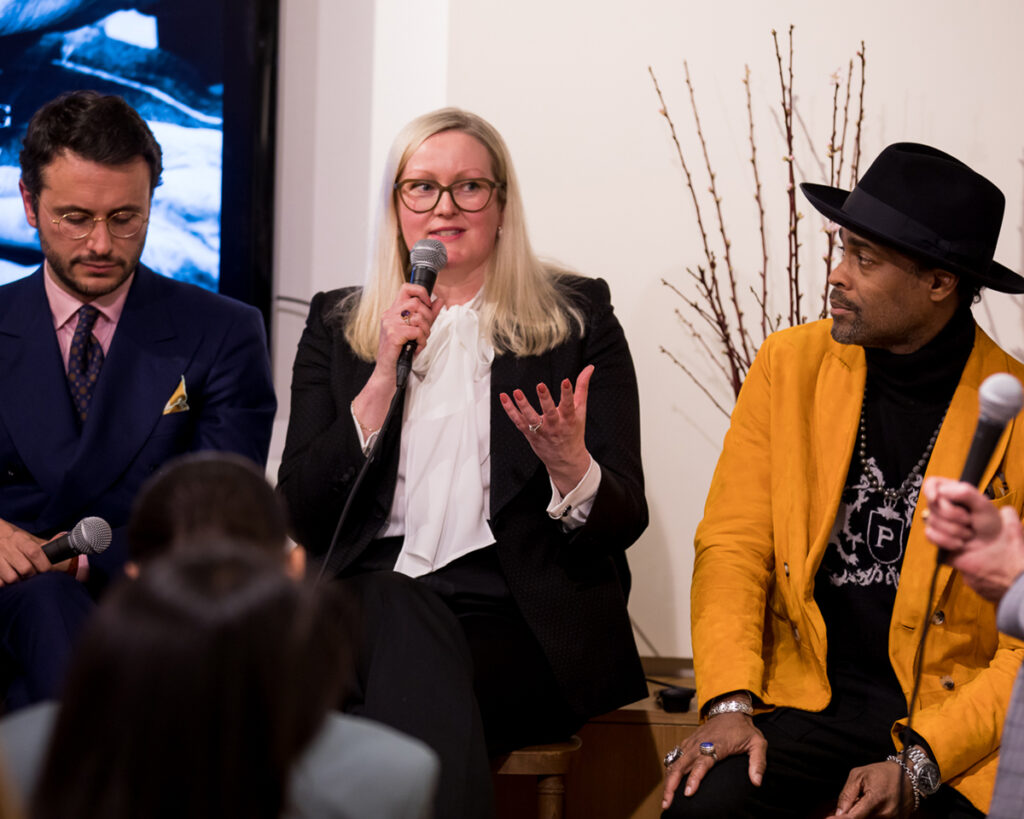GLADSON AND VITALE BARBERIS CANONICO’S “REBOOTING THE SUIT” PANEL DISCUSSION

On Thursday, March 9th, Gladson New York and Vitale Barberis Canonico co-sponsored “Rebooting the Suit,” a panel discussion at Gladson’s West 56th Street showroom. The event included a talk and book signing by Fabio Attanasio (author of “Scent of Tailoring”) some lively commentary on the state of tailored clothing, and festive cocktails both before and after the discussion, complete with an exceptional jazz trio.
The evening’s main topic? The ubiquitous men’s suit has changed little in 400 years. Is it time for a “suit reboot?” While the conversation ranged from the importance of fabric, storytelling, and customer guidance, in the end, the conclusion seems to be that the suit is doing just fine, evolving and changing with the times while remaining firmly planted in tradition. Educating customers that a well-fitted suit is as comfortable as sportswear (even if that may mean updating models with today’s performance-oriented fabrics), and that tailored garment means being able to have whatever you want (assuming it will look good on you) were the main takeaways of the evening.

Guy Milinazzo, Executive Vice President of Gladson New York opened the evening’s festivities, introducing the panelists and the moderator, MR’s own Karen Alberg Grossman (Editor’s note: we may be a little biased, but if anybody is looking for the next Ellen, Dr. Phil, or Oprah, Karen is ready!)
Karen got things rolling with a Q&A with Attanasio (read her interview with him here), who explained how he researched modern tailoring by going right to the source, from Rome to Milan to Naples, then on to Paris and London. He even brought several of his own suit jackets to demonstrate some of the more subtle approaches to regional styles.

The evening’s other panelists were Valentina Berti, PR and Communications Manager, Vitale Barberis Canonico, (who leads the company’s global communications, training programs, and its Fabric Academy). Vaughn Granger Sr., of Granger Owings, the family-owned specialty boutique in Colombia, South Carolina, represented retailers, while Karl-Edwin Guerre, photographer and editor-in-chief of No Chaser Magazine, brought more media star power (not to mention his personal exceptional taste level) to the event. Tailors were exquisitely represented by Jorge Saez of Artigiano Coral Gables, from Florida, Shao Yang of The Tailory New York, (whose customers include men, women, and transgender individuals), and Kathryn Sargent, Savile Row’s first female tailor.
The discussion can be watched in its entirety on YouTube, but here are just a few of the outstanding quotes we heard that evening.
Jorge Saez
“The suit business is not dead. Business for us is up! People always ask, “Who buys suits in Florida? It’s 85 or 90 degrees all the time!” Everybody buys suits in Florida. First, there are always going to be events: Weddings, funerals, work, job interviews, and so forth. Second, the work uniform may be dead, but the wealthy want to set themselves apart. They want to wear something special, and a suit elevates whoever is wearing it.
“We need to embrace technical fabrics. That’s the future.
“You don’t have to have a shoulder pad or a structured-looking suit to be dressed. In Europe, most people don’t wear shoulder pads and they still look very elegant. I think that’s a misconception in the United States.
“Sometimes you have to say no! If the customer looks good, you look better, but if they look bad, you’ll look bad. Look at what the guy is wearing. If he dresses well then you give him what he wants. If he doesn’t, you have to kind of show him what you do and give him the proper advice.”
Kathryn Sargent
“People are really investing in themselves. We’ve all been locked up the last couple of years and we want to express our own individual personal styles. People are coming to me for traditional suits, but I’m also doing what I’m calling ‘flexible tailoring,’ that is suits that could be broken up into different outfits.
“It’s about the journey and the craft and experience. When you’re going to see a tailor, you’re not just buying a product that you’ve seen in a magazine advertisement, you’re buying into that person and their service and experience. We all need that human connection.
“We also need to educate on cloth and on what’s going to last. The first thing you should do when looking at fabric is feel it and get a feeling for its performance. As a tailor, I get so much joy in recommending certain fabrics for certain styles. If someone has a suit or a garment you’ve made for them and it lasts for years and years, they’re going to come back and trust you more next time. That also addresses sustainability issues.
“Bespoke is about working with individuals to help them express and capture their personal style. I don’t have a signature look: I work with individuals who are probably replacing a favorite fashion piece from their wardrobe or something vintage that they want to replicate It’s about the joy of creating something individual and special. When you go to a tailor, you have a blank canvas, so anything is possible. Everyone is discovering the joy of this experience.”
Shao Yang
“The experience and the human connection are important in custom clothing, but we’re doing well by bringing a designer touch to the experience. For so long a customer would go to a tailor because he needed a business suit or a tuxedo for a wedding. All very traditional. There are a lot of rules with custom tailoring: We break all the rules, and that’s what we do best. When people come to us, they’re coming to us for that different approach. Some of our most popular pieces aren’t suits. We do something a little bit more related to sportswear. We call it athleisure or the yoga suit or the workout suit. Different from what they would normally see.
[metaslider id=220118]Valentina Berti
Customers have become very knowledgeable and want to know a lot about who is making the fabric, as well as the quality. It’s very important to educate those final customers about what we produce. Thanks to Gladson we do an amazing job in training the next generation of designers about the raw materials because, of course, 70% of a suit is the fabric! We really believe in education.”
Vaughn Granger
“We do a lot of off-the-rack clothing, but 54% of what we do is in custom. What we’re finding is that we have to figure out if the consumer wants to be a Ford 150 kind of suit guy or if he wants to be a BMW suit guy. It’s not about judging them, but figuring out whether to steer them to off the rack or custom.
“People are getting back to work, and we’re seeing a lot of weddings and business attire coming back, so that’s going to impact both custom and off-the-rack.”
Guerre
“I think it starts off with understanding yourself and having a better understanding of what works for you. This is something you learn from tailors. When you go to a tailoring house, you may want a certain fabric, but the tailor will tell you what works.
“Once you know what’s good for you, that’s the starting point. Then it’s easy because if you have a closet full of things that are good for you, it’s very easy to just go in here and grab pieces. Tailors put pieces together for that purpose. If it’s a good quality piece, then it’s easy to match it with something else and it becomes your style. Once you have a certain style, then it’s very easy to mix and match pieces.
“There’s a disparity between tailors and fashion houses: They understand how to push the envelope, and that’s their job. They have the budget for it. They’re willing to do that, and the masses can follow. A tailor’s responsibility is to make sure the customer looks great. But there’s almost a separation because if those two aren’t talking, how can we get to see a product like this done well? A fashion house isn’t going to give you a quality garment. It almost as if tailors are preaching to the choir. You’re speaking to a customer that already knows and understands. How do you communicate that to somebody who isn’t wearing a similar role? How do you bring someone into the world of bespoke, or into suiting period?
Fabio Attanasio
Do we need to bring more people to the industry? Bespoke tailoring isn’t for everyone. I want to say something unpopular: Ferrari would like to have the same number of customers and sell them the highest number of cars. That’s it. But it’s got to be the right customers. The challenge of us as educators is to share the beauty of the craft, to try to adapt, and attract more people to the industry. But at the end of the day, some people just don’t want to want to be educated.
Many, many thanks to the Gladson and Barberis team for bringing together a truly educational and inspiring evening.



